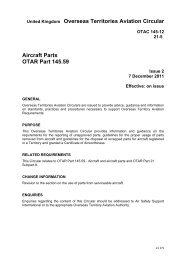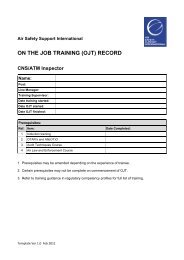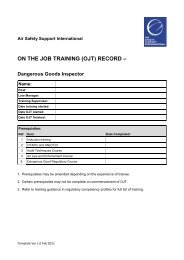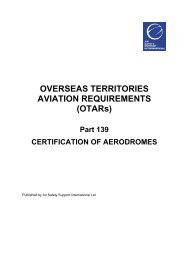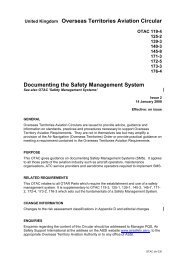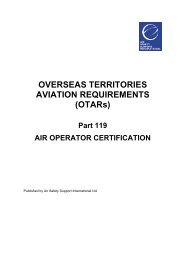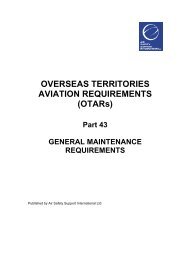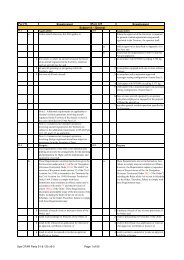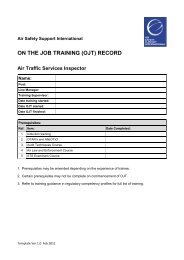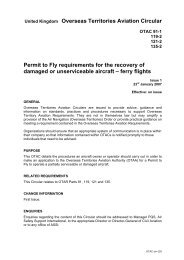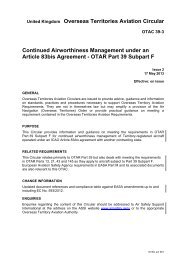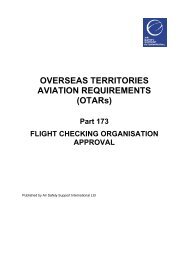Aerial Work and Specialised Operations - Air Safety Support ...
Aerial Work and Specialised Operations - Air Safety Support ...
Aerial Work and Specialised Operations - Air Safety Support ...
You also want an ePaper? Increase the reach of your titles
YUMPU automatically turns print PDFs into web optimized ePapers that Google loves.
United Kingdom Overseas Territories Aviation CircularOTAC 91-8<strong>Aerial</strong> work <strong>and</strong> specialised operationsIssue 1October 2012Effective: on issueGENERALOverseas Territories Aviation Circulars are issued to provide advice, guidance <strong>and</strong>information on st<strong>and</strong>ards, practices <strong>and</strong> procedures necessary to support OverseasTerritory Aviation Requirements. They are not in themselves law but may amplify aprovision of the <strong>Air</strong> Navigation (Overseas Territories) Order or provide practical guidance onmeeting a requirement contained in the Overseas Territories Aviation Requirements.PURPOSEThis Circular provides guidance on aerial work <strong>and</strong> specialised operations, including theneed for risk assessments for the operations to be undertaken.RELATED REQUIREMENTSThis Circular relates to OTAR Part 91. See also OTAC 91-2 Commercial <strong>Air</strong> Transport <strong>and</strong>Private <strong>Operations</strong>.CHANGE INFORMATIONFirst issue.ENQUIRIESEnquiries regarding the content of this Circular should be addressed to <strong>Air</strong> <strong>Safety</strong> <strong>Support</strong>International or to the appropriate Overseas Territory Aviation Authority.OTAC s/n 086
<strong>Aerial</strong> <strong>Work</strong> & <strong>Specialised</strong> <strong>Operations</strong> OTAC 91-8TABLE OF CONTENTS1 INTRODUCTION ...................................................................................................................... 32 THE REQUIREMENTS EXPLAINED ....................................................................................... 33 TASK SPECIALISTS ............................................................................................................... 44 OPERATIONS FOR WHICH PERMISSION IS REQUIRED .................................................... 45 RISK ASSESSMENT – WHAT IS INTENDED ......................................................................... 56 GENERIC AND DYNAMIC RISK MANAGEMENT .................................................................. 6APPENDIX A STANDARD OPERATING PROCEDURES (SOPS) ............................................... 7APPENDIX B EMERGENCY RESPONSE PLANNING ................................................................. 9APPENDIX C EXAMPLE PERMISSION DOCUMENT ................................................................. 10OTAC s/n 086 Issue 1 Page 2 of 11
<strong>Aerial</strong> <strong>Work</strong> & <strong>Specialised</strong> <strong>Operations</strong> OTAC 91-8Note 2: When conducting the risk assessment <strong>and</strong> developing SOPs, operatorsof complex general aviation or commercial air transport aircraft shouldutilise their safety management systems, <strong>and</strong> ensure that the st<strong>and</strong>ardoperating procedures requirements in Subpart B of the applicable OTARare satisfied; i.e. OTAR Part 121, 125 or 135. Guidance on SOPs isincluded at Appendix A.3 Task specialists3.1 The term ‘Task specialist’ is defined as follows –Task specialist means a person assigned by the operator or a third party, oracting as an undertaking, who:(a)(b)performs tasks on the ground directly associated with a specialised task;orperforms specialised tasks on board or from the aircraft.3.2 From a legal point of view, task specialists are either crew members orpassengers. In accordance with the definition of ‘Crew’, a task specialist who isassigned by the operator to perform specialised tasks on board or from theaircraft is a member of the crew. If not assigned by the operator to performspecialised tasks on board or from the aircraft (for example a ground workerassociated with a specialised task), a task specialist is a passenger.4 <strong>Operations</strong> for which permission is required4.1 The permission of the Governor is required before a foreign-registered aircraft isused for aerial photography, aerial survey or any other form of aerial work. Inthis context a “foreign-registered aircraft” is an aircraft registered in aContracting State other than the United Kingdom or any of the Territories, or ina foreign country.4.2 In addition to the above, for certain specialised operations the permission of theGovernor is required. Such specialised operations include: aerial application forthe purposes of agriculture, horticulture, forestry or conservation; helicopterexternal load operations (HELO); helicopter hoist operations (HHO) 2 ; <strong>and</strong>dropping of persons (parachuting) 3 . Operators conducting any of thesespecialised operations are required to have an operations manual –• containing such information <strong>and</strong> instructions as may be necessary to enableemployees <strong>and</strong> persons engaged in the operation to perform their duties;• that includes SOPs (as previously described); <strong>and</strong>• defining the duties <strong>and</strong> accountabilities of those persons responsible formanaging the safe operation of aircraft.2 'Helicopter hoist operations' refers to a flight the purpose of which is to facilitate the transfer ofpersons <strong>and</strong>/or cargo by means of a helicopter hoist. HHO where any person on the hoist is not acrew member must comply with the requirements applicable to commercial air transport operations.3 Separately from the dropping of persons, the dropping of articles <strong>and</strong> animals is generallyprohibited, therefore an exemption from AN(OT)O article 130 may be required for such tasks.OTAC s/n 086 Issue 1 Page 4 of 11
<strong>Aerial</strong> <strong>Work</strong> & <strong>Specialised</strong> <strong>Operations</strong> OTAC 91-8in the event of a real aircraft emergency should be considered. In this examplean engine failure could be a significant hazard; potentially leading to confusionabout which pilot is flying, <strong>and</strong> a risk of loss of control of the aircraft.6 Generic <strong>and</strong> dynamic risk management6.1 Generic risk management is a structured process that prepares for the conductof an activity in general terms. It is important because it gives consistency to theway the operation is conducted, particularly when a task is to be repeated<strong>and</strong>/or different people are involved.6.2 Dynamic risk management refers to the ongoing assessments we make duringthe conduct of an operation. It is a continuous process of identifying hazards,assessing risk, <strong>and</strong> taking action to eliminate or reduce risk. It should becomplementary to the generic risk management process.6.3 The majority of risks should be reasonably foreseeable, therefore SOPs,training, <strong>and</strong> the assignment of tasks should provide a sound basis for dynamicrisk management. An example would be the operational risk managementperformed during flight, where the crew should normally be making decisionsbased on a known repertoire, <strong>and</strong> surprises should be rare.The following questions may help –Have all the major hazards related to the intended activity been identified?Have the risks been assessed in terms of severity <strong>and</strong> likelihood?Were the right people involved in doing the risk assessment, i.e. including thosewho will be conducting the tasks?What are the criteria for evaluating the level of risk you are willing to accept?Do your SOPs contain effective <strong>and</strong> robust mitigations <strong>and</strong> controls in relation tothese risks?Are the SOPs provided in a way that is clear <strong>and</strong> meaningful to operating staff?Do your SOPs make provision for coping with an emergency <strong>and</strong> the associatedrisks, i.e. an appropriate emergency response plan (ERP)? (See Appendix B)Do you have a method in place so it is easy for operating staff to report new orchanged hazards <strong>and</strong> concerns? Does this include a provision so that peoplecan propose preventive <strong>and</strong> corrective actions?OTAC s/n 086 Issue 1 Page 6 of 11
<strong>Aerial</strong> <strong>Work</strong> & <strong>Specialised</strong> <strong>Operations</strong> OTAC 91-8Appendix ASt<strong>and</strong>ard Operating Procedures (SOPs)The content of this appendix is reproduced from ICAO Document 8168 – PANS-OPS, Volume I, Part III, Section5, Chapter 1.1.1 GeneralOperators shall establish st<strong>and</strong>ard operating procedures (SOPs) that provide guidance toflight operations personnel to ensure safe, efficient, logical <strong>and</strong> predictable means ofcarrying out flight procedures.Note.— The Preparation of an <strong>Operations</strong> Manual (Doc 9376), Chapter 8, 8.6.2, includesgeneral considerations about SOPs. The Human Factors Training Manual (Doc 9683), Part1, Chapter 2, 2.5.11, includes general considerations about SOPs design.1.2 SOPs – ObjectivesSOPs specify a sequence of tasks <strong>and</strong> actions to ensure that flight procedures can becarried out according to 1.1. To achieve these objectives, SOPs should unambiguouslyexpress:a) what the task is;b) when the task is to be conducted (time <strong>and</strong> sequence);c) by whom the task is to be conducted;d) how the task is to be done (actions);e) what the sequence of actions consists of; <strong>and</strong>f) what type of feedback is to be provided as a result of the actions (verbal call-out,instrument indication, switch position, etc.).1.3 SOPs – Design1.3.1 To ensure compatibility with specific operational environments <strong>and</strong> compliance byflight operations personnel, SOPs design should take into consideration:a) the nature of the operator’s environment <strong>and</strong> type of operation;b) the operational philosophy, including crew coordination;c) the training philosophy, including human performance training;d) the operator’s corporate culture, including the degree of flexibility to be built intoSOPs design;e) the levels of experience of different user groups, such as flight crews, aircraftmaintenance engineers <strong>and</strong> cabin attendants;f) resource conservation policies, such as fuel conservation or wear on power plants<strong>and</strong> systems;OTAC s/n 086 Issue 1 Page 7 of 11
<strong>Aerial</strong> <strong>Work</strong> & <strong>Specialised</strong> <strong>Operations</strong> OTAC 91-8g) flight deck automation, including flight deck <strong>and</strong> systems layout <strong>and</strong> supportingdocumentation;h) the compatibility between SOPs <strong>and</strong> operational documentation; <strong>and</strong>i) procedural deviation during abnormal/unforeseen situations.1.3.2 Flight operations personnel should be involved in the development of SOPs.1.4 SOPs – Implementation <strong>and</strong> useOperators should establish a formal process of feedback from flight operations personnel toensure st<strong>and</strong>ardization, compliance <strong>and</strong> evaluation of reasons for non-compliance duringSOPs implementation <strong>and</strong> use.OTAC s/n 086 Issue 1 Page 8 of 11
<strong>Aerial</strong> <strong>Work</strong> & <strong>Specialised</strong> <strong>Operations</strong> OTAC 91-8Appendix BEmergency response planningAn emergency response plan (ERP) should provide the actions to be taken in anemergency. It should reflect the size, nature <strong>and</strong> complexity of the activities performed bythe organisation.In many cases there will be a need for local liaison with other relevant parties to agreecoordination arrangements.The ERP should ensure:a) an orderly <strong>and</strong> efficient transition from normal to emergency operations;b) designation of emergency authority;c) assignment of emergency responsibilities;d) authorisation by key personnel for actions contained in the plan;e) coordination of efforts to resolve the emergency; <strong>and</strong>f) safe continuation of operations or return to normal operations as soon aspracticable.The ERP should set out the responsibilities, roles <strong>and</strong> actions for the various agencies <strong>and</strong>personnel involved in dealing with emergencies. It may include checklists <strong>and</strong> contactdetails <strong>and</strong> the ERP should be regularly reviewed <strong>and</strong> tested. Key personnel should haveeasy access to the ERP at all times.Some points to considerThings that can't happen do happen.Think – what if ?• summer/winter/other season• 2 events at once• deliberate/hostile acts• accidentsClassify the emergency(s)Provide checklistsAre callout lists up to date? (telephone numbers)Are you reliant on mobile phones?Avoid e.g. the managing director trying to take control.Access/gate control (proper procedures so emergency services not delayed by routinesecurity).When will alarms be silenced? When they are: need for tannoy announcement to explain"to aid communications".Expectations of neighbours –• schools• housing• other companiesTrain to underst<strong>and</strong> the risks – <strong>and</strong> the risks of escalation.OTAC s/n 086 Issue 1 Page 9 of 11
<strong>Aerial</strong> <strong>Work</strong> & <strong>Specialised</strong> <strong>Operations</strong> OTAC 91-8Appendix CExample permission document<strong>Air</strong> Navigation (Overseas Territories) Order 2013PERMISSION Number: SH 13-991 <strong>Air</strong> <strong>Safety</strong> <strong>Support</strong> International (ASSI), in exercise of the powers of the Governor ofSaint Helena under article 128 <strong>and</strong> 129 of the <strong>Air</strong> Navigation (Overseas Territories)Order 2013 (the AN(OT)O), hereby permits trading as (the Operator) to conduct aerial application <strong>and</strong> helicopter external load operations(HELO) from any helicopter operated by the Operator.2 ASSI, in exercise of the powers of the Governor of Saint Helena under article 137 ofthe AN(OT)O, grants permission for use of the foreign-registered aircraft specified inSchedule 1 in accordance with the conditions specified in this certificate.3 This Permission is granted subject to the following conditions:(a)(b)(c)(d)(e)operations shall be conducted in accordance with the relevant provisions of thepermission holder’s operations manual;operations shall be conducted by day only under visual flight rules (VFR);aerial application of rodent bait shall be limited to Gough Isl<strong>and</strong>;no person who is not a member of the flight crew shall be carried on a flightmade for the purpose of aerial application;continued airworthiness shall be in accordance with the requirements of theState of Registry of the aircraft (United States of America).4 This permission is not transferable <strong>and</strong> shall remain in force unless varied, suspendedor revoked from the date hereof until <strong>and</strong> including 31 October 2013........................................................................ DATE: 31 May 2013for <strong>Air</strong> <strong>Safety</strong> <strong>Support</strong> InternationalNOTES1 The granting of this permission satisfies the criteria for exemption from Rule5(3)(b) of the Rules of the <strong>Air</strong> ‘The 500 feet rule’, as accepted for droppingarticles with permission of the Governor under Rule 6(j)(ii) of The Rules of the<strong>Air</strong> in Schedule 4 to the AN(OT)O.OTAC s/n 086 Issue 1 Page 10 of 11
<strong>Aerial</strong> <strong>Work</strong> & <strong>Specialised</strong> <strong>Operations</strong> OTAC 91-82 An aircraft in flight shall not, by means external to the aircraft tow any article orpick up, raise or lower any person, animal or article, unless there is a certificateof airworthiness issued or rendered valid in respect of that aircraft under thelaw of the country in which the aircraft is registered <strong>and</strong> that certificate or theflight manual for the aircraft includes an express provision that it may be usedfor that purpose. (AN(OT)O article 129)3 Guidance on best practice is available in United Kingdom Civil AviationPublication CAP 414 ‘The <strong>Aerial</strong> Application Certificate’ <strong>and</strong> CAP 426‘Helicopter External Load <strong>Operations</strong>’.SCHEDULE 1Bell Helicopter 206B N206PABell Helicopter 206B N5754KOTAC s/n 086 Issue 1 Page 11 of 11




